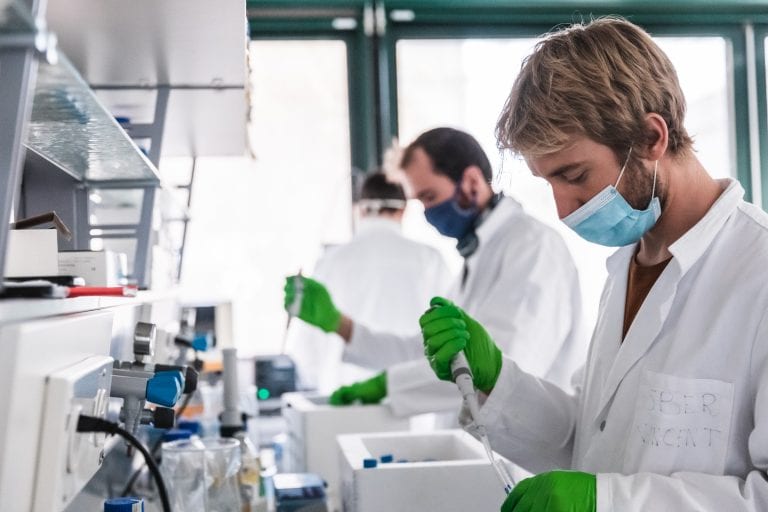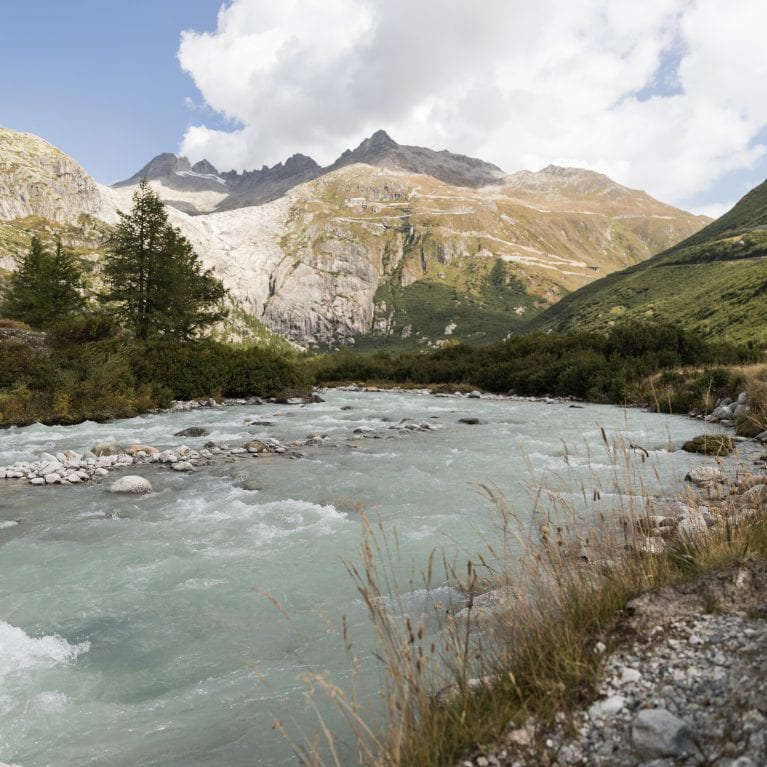The field scientists working on the Vanishing Glaciers project, supported by The NOMIS Foundation, aren’t afraid of heights. They climb to the icy peaks of mountain ranges from the Himalayas to the Alps, equipped with vials, pipettes, thermometers and liquid-nitrogen cylinders (which they’ve nicknamed Dido and Fido). Their goal is to collect samples of the microorganisms living in glacier-fed streams and bring them back to EPFL for analysis by their colleagues.
“We need to act now, before it’s too late”
As the world’s glaciers disappear, they are taking with them well-kept secrets. Glacial melting is one of the most visible signs of climate change and will eventually cause glacier-fed streams to dry up – destroying an important, unique ecosystem.
Scientists at EPFL’s Stream Biofilm and Ecosystem Research Laboratory (SBER) are working hard to learn those secrets before it’s too late. “These streams drain the roof of our planet,” says Tom Battin, head of SBER and the project’s lead scientist. “While we know that the planet’s biogeochemical cycles are generally orchestrated by microorganisms, we don’t yet understand the exact role of microorganisms living at high altitudes. So it’s essential that we study their ecosystems and map out what the consequences would be if they disappeared.”
Sampling the invisible
Out in the field, biofilms are the only visible evidence of the microorganisms populating glacier-fed streams – even though they’re there by the billions. Biofilms are the thin, greenish-looking, viscous layers that cover the streams’ rocks. In Arolla, in the canton of Valais, Martina Schön, a field technician working on the project, scrapes biofilm samples from a rock she spotted and carefully places them in her backpack for later analysis.
Meanwhile, fellow field technician Matteo Tolosano collects sediment samples. “We divided up the sampling work so that we can progress more quickly. But it’s an odd task because we’re sampling something that’s basically invisible,” he says. Nearby, Vincent De Staercke stands in the middle of a stream to perform another type of field work – measuring the oxygen concentration of the water where samples were collected, using sensors and fiber-optic cables connected to a computer. “It’s the only live data we have on the microorganisms,” says De Staercke. “If the oxygen concentration drops, that means bacteria are present because they’re breathing it in.”
Other members of the project team are responsible for collecting samples of glacier run-off water and analyzing its nutrients and ion concentrations. This will give an indication of what conditions are needed for bacteria populations to live and grow. Mike Styllas, an expedition leader, explains: “Bacteria are like us – they want to eat! But in these waters there’s not a lot of choice on the menu.”
In addition to studying microbial life, the research team is also looking closely at the surrounding environment. “We’re trying to get a detailed snapshot of the ambient conditions,” says Schön. “One way to do this is by taking measurements of variables like water temperature, oxygen concentration, carbon dioxide level and pH.”

From mountain peaks to the research lab
So far, the team has collected water and sediment samples from over 100 glacier-fed streams in New Zealand, Russia, Greenland, Ecuador, Scandinavia and the Alps. These samples are now being analyzed at SBER. Hannes Peter, a scientist at SBER, explains: “These samples are exceptional due to the extreme conditions they came from. One of the first steps we had to take in this project, and one of the most important, was to design our testing protocols for optimal efficiency so that we can perform all the analyses we want to.”
The SBER scientists also divided up their work for maximum effectiveness. One group is studying microbial ecology, that is, the microorganisms’ role in their habitat and community and how they behave. “We look at factors related to the biomass, which is the amount of living organisms in our samples,” says Peter. “For instance, we measure chlorophyll a concentrations – an indicator of algae – count the number of bacteria cells, and conduct experiments on bacteria production.”
Tyler Kohler, a postdoc at SBER, is in charge of measuring extracellular enzymes, which, he says, “are great because they let us read the bacteria’s minds.” These enzymes, also called exoenzymes, are produced by bacteria when a compound they need – like carbon or nitrogen – is found in their surroundings. “Studying exoenzymes gives us an idea of what helps the bacteria grow and reproduce,” says Kohler.
At the same time, other SBER scientists are sequencing and analyzing the DNA found in the samples. They are using metagenomics to sequence the genomes of several different species living in the same environment, and to answer crucial questions like: What’s there? Why? How? “Our analyses will tell us exactly how diverse the microbial community is in our samples and let us identify the genomes of some of those microorganisms, regardless of what community they’re in,” says Paraskevi Pramateftaki, a technical expert.

Samples, tell us everything
The wealth of data generated in this project will provide important insight into the strategies microbes have adopted to survive under such extreme conditions. This study marks the first time that biogeochemical information about glacier-fed streams is being combined with data on the structure and function of the microorganisms living in those streams.
What have the scientists discovered so far? First, that there is a vast and varied amount of microbial life in the streams. “Just one teaspoon of sediment can contain up to a million bacteria cells and hundreds of microbial species,” says Battin.
Second, that pretty much the same groups and species of microorganisms can be found regardless of where the samples are taken. This indicates that the microorganisms have adapted perfectly to their environments.
And last but not least, that because the microorganisms have very little capacity to evolve under such extreme conditions, they have undergone microevolution. Battin explains: “Microevolution has created a highly specific kind of microdiversity that is found only in these bacteria populations. And since the glacier environment is changing, the risk is that the microevolution process – and microdiversity – will disappear, taking with it some of the planet’s biodiversity on a larger scale.”

Understanding the invisible
The Vanishing Glaciers project has, like the rest of the planet, been affected by the pandemic, but the scientists still hope to carry out their planned expeditions to Nepal, Central Asia, the Andes and Alaska. In the meantime, they are still crunching the data from samples already collected. “Our goal is to be able to unlock the secrets of microbial life in glacier-fed streams within the next few years, and to predict how the streams and their microbiomes will change as the world’s glaciers vanish,” says Battin. “In other words, we want to better understand the invisible.”

























